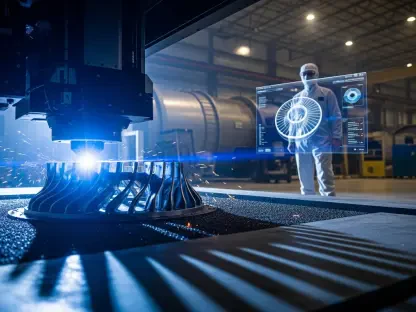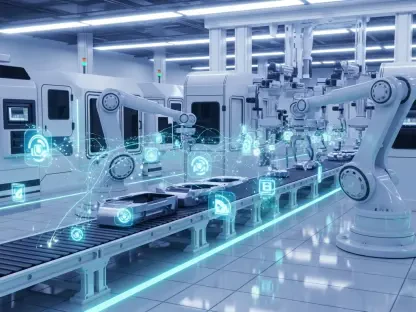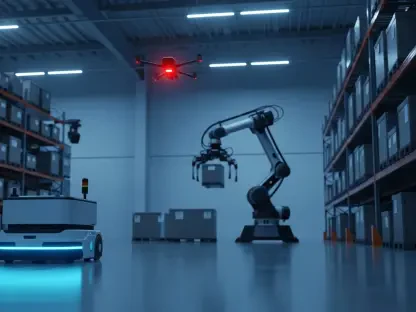The manufacturing industry is facing an unprecedented surge in cyberattacks, with the frequency, magnitude, and financial impact of these attacks escalating rapidly. According to IBM’s 2024 X-Force Threat Intelligence Report, manufacturing has been the primary target of cyberattacks for three consecutive years, representing more than 25% of incidents. In 2023 alone, 70% of ransomware attacks targeted manufacturers, resulting in millions of dollars in losses. The World Economic Forum predicts that the global financial impact of cyberattacks could reach $10 trillion by 2025.
The Lucrative Payoffs for Cybercriminals
Valuable Intellectual Property and Operational Data
Manufacturers possess valuable intellectual property, proprietary designs, and critical operational data, making them prime targets for cybercriminals. The integral role of manufacturers in supply chains and the broader economy means that operational disruptions can cause widespread impacts, providing attackers with substantial leverage in ransomware scenarios. A notable example is the September 2023 ransomware attack on Johnson Controls, which resulted in losses exceeding $27 million. This demonstrates how cybercriminals can exploit vulnerabilities to gain access to invaluable data, directly impacting manufacturing operations and causing vast financial repercussions.
Furthermore, the interconnected nature of the manufacturing industry means that a single attack can have a cascading effect on multiple companies within the supply chain, amplifying the overall damage. The attackers’ ability to extort large sums of money from these organizations hinges on the critical nature of their operational data and the potential chaos that downtime can create. Such scenarios make manufacturers more likely to comply with ransom demands to quickly restore their systems, further incentivizing cybercriminals to target this lucrative sector.
Increasing Frequency of Ransomware Attacks
David Chaddock, managing director in West Monroe’s cybersecurity practice, highlights that the success of initial ransomware attacks has led to more cybercriminals targeting manufacturers. By disrupting production lines, attackers can cause significant financial damage, similar to targeting hospitals. The cost of downtime for manufacturers is substantial, often compelling companies to pay the ransom to quickly resume operations and minimize revenue loss. This trend indicates that the financial incentives for attackers are growing stronger, leading to an increase in both the frequency and sophistication of these attacks.
Moreover, the manufacturing sector’s high potential for quick payouts has made it an attractive target for cybercriminals. The attackers’ strategy often includes encrypting crucial operational data, thereby crippling production capabilities. The urgency to get back online means that many companies choose the path of least resistance—paying the ransom. This perpetuates a cycle where successful ransom payments only embolden cybercriminals to target more manufacturers, knowing that these organizations might be compelled to meet their demands to avert prolonged disruptions and financial losses.
Vulnerabilities in Industrial Control Systems
Outdated Technology and Legacy Systems
One critical factor contributing to the vulnerability of manufacturers to cyberattacks is their reliance on outdated industrial control systems and operational technology (OT) equipment. These legacy systems, often designed decades ago without built-in security features, cannot be easily patched or updated without risking operational disruption. This leaves known vulnerabilities unaddressed for extended periods. As these old systems continue to be a mainstay in many manufacturing plants, they provide a clear and persistent target for cybercriminals looking to exploit weaknesses.
In addition, the process of updating or patching these legacy systems involves significant downtime, which can halt production and incur substantial costs. This presents a dilemma for manufacturers: either take the necessary security measures and halt production or maintain operations and potentially expose sensitive systems to cyber threats. Many companies, prioritizing continuous production, opt to delay or avoid these updates, thereby perpetuating the risks associated with their outdated technology. This chronic exposure creates fertile ground for cyberattacks, as unresolved vulnerabilities remain exploitable.
Expanding Attack Surface with Digitalization
Simultaneously, the increasing digitalization of manufacturing operations through Industrial Internet of Things (IoT) devices and internet-connected sensors has expanded the attack surface. These digital systems, although modern, introduce new cyber threats, rendering manufacturers even more susceptible to attacks. The requirement for continuous operation in the manufacturing industry, combined with the high cost of downtime, forces security teams to make difficult choices between maintaining production and implementing necessary security measures. This rapidly evolving technological landscape means that manufacturers are perpetually playing catch-up, trying to secure newly integrated systems while keeping operations smooth.
The proliferation of IoT devices and internet-connected sensors in manufacturing environments provides cybercriminals with more points of entry. Each new connected device represents a potential vulnerability that can be exploited to gain access to critical systems. As manufacturers embrace these technologies to drive operational efficiency, they inadvertently expand their cyber risk footprint. The complexity of securing these interconnected technologies, combined with the relentless pace of technological advancement, exacerbates the challenge of maintaining robust cybersecurity defenses in an industry that cannot afford downtime.
The Rush to Implement New Technologies
Operational Efficiency vs. Security Considerations
The rush to implement new technologies for operational efficiency has often outpaced security considerations, amplifying cyber threats. Keatron Evans, VP of portfolio product and AI strategy at Infosec, notes that many manufacturers lack proper understanding or training in the technologies they adopt, such as cloud computing and cloud security. This knowledge gap leaves many systems inadequately protected, exposing companies to higher risks. Manufacturers’ eagerness to harness the benefits of modern technology often results in insufficiently vetted security protocols and rushed implementations that fail to address all potential vulnerabilities.
Additionally, the ongoing labor crunch exacerbates this issue, as staff may be forced to take on additional tech operational and cybersecurity responsibilities without the necessary specialized skills. The shortage of skilled cybersecurity professionals further complicates efforts to secure new technologies. Frequently, existing personnel, already stretched thin, are tasked with managing sophisticated cyber defenses, a role for which they might not be fully prepared. This juggles the demands of maintaining production efficiency while ensuring comprehensive security measures, often leading to compromises and oversight.
Human Error and the Need for Training
Labor is a critical component in cybersecurity, with 95% of breaches resulting from human error, according to the World Economic Forum. To mitigate this risk, it is essential to control the human factor through adequate training and stringent protocols for accessing sensitive data. Manufacturers must prioritize comprehensive training programs to ensure that their workforce is well-equipped to handle the complexities of modern cybersecurity threats. Providing consistent and up-to-date cybersecurity training can significantly enhance employees’ ability to recognize and mitigate potential threats, reducing the likelihood of successful attacks.
Incorporating regular training and awareness programs into the organizational culture is vital. Employees should be educated on the latest cyber threats, safe practices for handling data, and procedures for responding to suspicious activities. Building a strong foundation of cybersecurity knowledge among all personnel, not just IT staff, can create a more resilient defense against human error-induced breaches. By fostering a culture that prioritizes cybersecurity awareness and vigilance, manufacturers can substantially decrease the risks associated with human factors in cyber incidents.
The Role of Third-Party Vendors
Interconnected Global Supply Chains
Manufacturers are heavily reliant on third-party vendors and interconnected global supply chains, making them vulnerable to the cyber infrastructure of their partners. Even if a manufacturing firm has strong security measures, it can still be compromised by its partners’ security processes. Resilience’s Midyear 2024 Cyber Risk Report indicates that 35% of claims in 2023 originated from vendor failures. This statistic highlights the importance of thoroughly vetting and continuously monitoring third-party vendors to ensure they adhere to stringent cybersecurity protocols.
Failure to ensure that supply chain partners maintain robust security standards can lead to significant vulnerabilities. Working closely with third-party vendors to establish clear cybersecurity expectations and regular audits can help identify and mitigate potential weaknesses. By fostering strong communication and collaboration with their suppliers, manufacturers can enhance the overall security posture of their interconnected operations, thereby reducing the likelihood of cyber incidents stemming from third-party failures.
Rethinking Cybersecurity Approaches
Shattuck emphasizes the need for manufacturers to rethink their approach to cybersecurity. Instead of viewing it as a black-and-white issue of being hacked or safe, manufacturers should consider their level of risk based on typical attack patterns in the industry, the impact of a cyberattack on operations, the tools needed to restore operations, and the coverage of their cyber insurance policy. Regularly asking these questions and making necessary changes can help manufacturers maintain business continuity and avoid significant financial losses even if they are hit by a cyberattack.
Adopting a more nuanced approach to cybersecurity, one that involves continuous risk assessment and proactive planning, can enhance a manufacturer’s ability to respond effectively to cyber threats. Companies should implement robust incident response plans, invest in advanced cybersecurity tools, and ensure their cyber insurance policies adequately cover potential damages. This mindset shift, from reactive to proactive cybersecurity management, is essential for navigating the increasingly complex threat landscape and safeguarding manufacturing operations against persistent cyber threats.
Balancing Production and Cybersecurity
The Complex Nature of Cybersecurity Challenges
The complex and multifaceted nature of cybersecurity challenges in the manufacturing industry demands a balanced approach between maintaining production and adopting robust cybersecurity measures. The urgency to keep production lines running smoothly often conflicts with the need to implement comprehensive security protocols, leading to difficult choices and potential compromises. By prioritizing comprehensive cybersecurity strategies that address both technological and human factors, manufacturers can better safeguard their operations and minimize the impact of cyberattacks on their businesses.
These strategies should encompass ongoing risk assessments, regular updates to security measures, and a strong culture of cybersecurity awareness and training among employees. By integrating these elements into their overall operational plans, manufacturers can create a resilient defense mechanism capable of adapting to evolving cyber threats. The challenge lies in achieving a harmonious balance where productivity and security coexist, ensuring that manufacturers can protect their critical assets without compromising their operational efficiency.
The Road Ahead for Manufacturers
The manufacturing sector is undergoing an unprecedented rise in cyberattacks, with an alarming increase in their frequency, scope, and financial repercussions. IBM’s 2024 X-Force Threat Intelligence Report highlights that, for three years in a row, manufacturing has been the prime target of cyberattacks, accounting for over 25% of all incidents. In 2023, a staggering 70% of ransomware attacks were aimed at manufacturers, resulting in multimillion-dollar losses. Additionally, the World Economic Forum forecasts that the global financial damage caused by cyberattacks could soar to $10 trillion by 2025. This highlights the urgent need for the manufacturing industry to invest in robust cybersecurity measures to protect their systems and data from these escalating threats. As the industry continues to modernize and adopt more digital technologies, the risk of cyberattacks will likely continue to grow, making it imperative for companies to stay ahead of potential threats and mitigate financial and operational risks.









